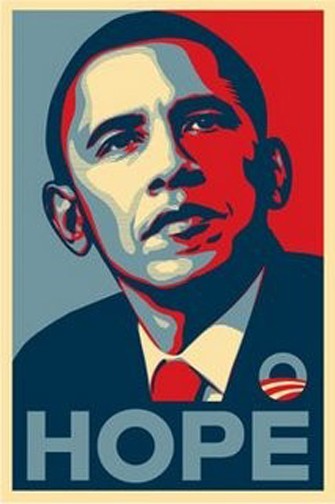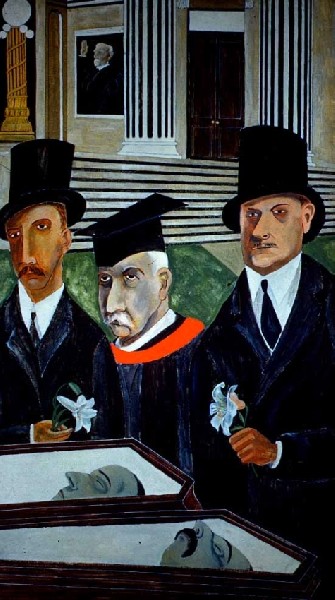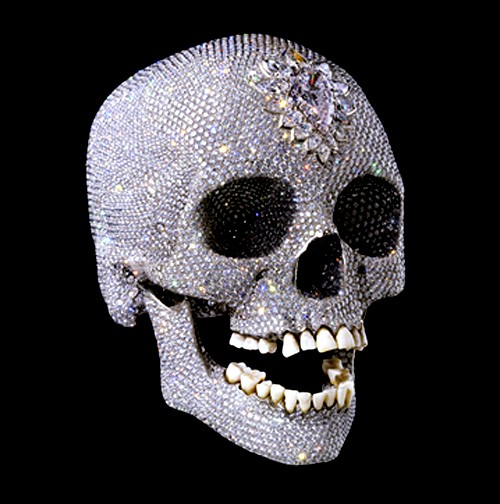Stimulus Bill Includes $50 Million for the Arts
Chump Change Is Better than Nothing
By: Charles Giuliano - Feb 17, 2009
Last week the arts were lumped together with casinos, zoos, aquariums, swimming pools, stadiums, and highway beautification projects in a motion by Senator Tom Coburn (Republican-Oklahoma) to be excluded from the $787 billion stimulus bill now signed by President Barack Obama and intended to create or preserve some 5 million jobs.
Extracting the arts from a laundry list of excluded categories entailed an enormous lobbying effort including a personal call from Robert Redford to speaker of the House, Nancy Pelosi. In response to Senator Coburn's motion it was revealed that his daughter is an emerging opera star. So there was some irony in his position.
The $50 million in the bill, a pittance at best, will be applied to the existing budget of $145 million for the National Endowment for the Arts. The bill stipulates that 40% of the $50 million will go to state art agencies and 60% will be applied to individual arts projects competing for Endowment grants. Even though increased to $195 million with the current United States population estimated at 303 million that represents less than a dollar per citizen for the arts. Or, a bit less than $2 million per state. This may seem substantial for Maine or Wyoming but is a drop in the bucket for New York, California, Illinois, Massachusetts, or Florida. The annual budget for the NEA has long been noted to roughly equal spending for military bands.
While some arts leaders view preserving $50 million in the stimulus bill as a victory others lament that in view of an ongoing crisis in the economy, which has been particularly devastating for the arts, there is slim expectation of any real impact.
The true pulse and tone of political support for the arts may reflect the statement by Representative Jack Kingston, Republican of Georgia "I just think putting people to work is more important than putting more art on the wall of some New York City gallery frequented by the elite art community." Kingston has described the arts as "the favorite of the left" and "call me a sucker for the working man."
The arts as sinful, decadent, and elitist is the familiar mantra of conservatives, red necks, and fundamentalists dating back to Cotton Mather and William Jennings Bryan. One may hear such ignorance spewed forth in the anti "liberal" laced invective of talk radio personalities such as Rush Limbaugh and Ann Coulter. Guess what, their trash talk prevailed for the eight years of the Bush administration, and just look where we are today. Given that terrible history and an era of unparalleled greed and corruption of the Bush era "liberal" and "cultural elite" no longer seem to be anathema. It is once again safe to proudly proclaim that I am an artist and a bleeding heart liberal from Massachusetts. Buzz off.
In fighting to keep the arts in the stimulus bill Americans for the Arts stated that Arts Organizations generate $166.2 billion in economic activity, support 5.7 million jobs, and pay $30 billion in taxes. Compared to the $195 million for the NEA, in response to the economic downturn, Germany, with a population of 82 million, recently allocated $2 billion for the arts and France, with a population of 61 million, has appropriated $4 billion for the arts.
By comparison to Europe the culture of America is relatively young and vulnerable. In the 19th century, when American artists traveled abroad to seek out art and culture, the landscape painters who remained at home were inspired to seek "That Wilder Image." The American sublime which competed with the ancient art and culture of Europe, was found in Niagara Falls, the Grand Canyon, the Rocky Mountains, along the Hudson River, the Mississippi, and in the Everglades. When the French philosopher Jean Baudrillard visited the United States and discussed its culture he wrote about Vegas. Arguably, our greatest and most unique cultural contributions are jazz, rock and Hollywood. Instead of the Parthenon we have Graceland and the Grand Ole Opry instead of La Scala. A better argument might be that the Parthenon is wonderful and so is Grace Land.
When it comes to government support for the arts there is an ongoing struggle. While the constitution guarantees freedom of expression it does not extend to supporting and subsidising that right. For that we are on our own. The support, as in the current stimulus bill, is not for the arts, but a broader recognition that there is a pressing need to create and preserve jobs. For every actor on stage, or picture on the wall of the museum, there are enormous support staffs. Also, whatever arts organizations receive in NEA and state grants are just an increment of their overall budgets. Typically, it represents no more than 10-20% of operating expense. Often it serves as the seed money for a project or expansion. It is the leverage to seek private and foundation support. NEA and state arts grants are consistently based on matching funding. It is the norm that every NEA dollar generates thirteen additional dollars.
Representative Louise M. Slaughter, a New York Democrat and co chair of the Congressional Art Caucus, has stated that "If we are trying to stimulate the economy, and get money into the Treasury, nothing does that better than art."
When Governor Deval Patrick undertook emergency cutbacks of the Massachusetts budget the arts took a hit. Money that had been appropriated was reduced or eliminated. Many arts organizations scrambled with emergency appeals. Just to keep up with projects their funding and marketing strategies have been set back for the next few years in a time of a devastated economy. Organizations hoping to retire mortgages and debt, planning to move on to building endowments, are now slashing staff and programming. Of course the first budget items to be cut are marketing and advertising. With reduced programming there will be fewer resources to stimulate ticket sales. Many are anticipating a very tough coming season.
The notion that the arts generate revenue and provide jobs is readily evident in the Berkshires. Without Tanglewood, Jacob's Pillow, renowned museums and theatre companies, the mountains of Western Massachusetts would be as hard scrabble as Appalachia. Because of the arts, vast mills and abandoned factories have been recycled as Mass MoCA, artist loft buildings, or condo complexes. Under former Governor, Michael Dukakis, Mass MoCA, was given $30 million in state funding as an economic stimulus for poverty stricken Northern Berkshire County. It was always more about jobs than culture.
For many and complex reasons the arts have never been embraced by the mainstream of America. It is this inherent disconnection and mistrust which is played upon and readily evoked by jingoists, evangelists, right wing pundits and politicians. In the blame game of what's wrong with America artists are easy and juicy targets.
In the melodrama of misunderstanding and ignorance the arts must take some responsibility for its excess. While Representative Kingston of Georgia has likely never spent an afternoon touring Chelsea he rants about government funding putting "Â…more art on the wall of some New York City gallery frequented by the elite art community." It doesn't quite work that way. He might be surprised to learn that many of us in the "elite art community" are less than thrilled by what is shown. During a typical gallery run I find myself absorbed by not more than about 10% of what is displayed. Someone should also tip off Kingston that a year from now perhaps a third or half of those galleries catering to the elite will be out of business. It seems that few of us are as elite as we used to be.
The behavior of the art market during the boom that led to the bust was as outrageous as the worst horror stories of Wall Street. But there is no easy target like Bernie Madoff or a rash of foreclosures to pin the blame on. In general, a work of art that sold for a million at the height of the global art fairs, would now bring perhaps ten cents on the dollar, if you can find a buyer. There are grim stories of New York galleries who have not made significant sales for the past year. While an exhibition of new work by Cindy Sherman, last fall, at Metro Pictures, did well, it did not, as has been the case in her prior shows, sell out.
For the past decade the art market has enjoyed growth and expansion. There has been a feeding frenzy as galleries raided each other for talent. A gallery might have one or two successful shows with an emerging artist only to lose the talent to someone higher up on the food chain. In an interesting developmen the British artist, Damien Hirst, sent a body of his latest work directly to auction denying top level galleries their usual commission. Hirst, and his diamond encrusted human skull, seemed to signify the greed and arrogance of the current art world.
But it is the success of the mega art stars and their celebrity lifestyle which has fueled and sustained the excesses of the culture industry. It gives hope to art students of graduating into a shot at the good life. There has been the absurd assumption of art as a viable profession. This in turn has transformed the role of art schools and universities from the training and education of artists into preparing them for success in the art market. For this, of course, the art schools and universities extract their fees. One egregious strategy has been to up the ante from the former terminal degree of an MFA to the newly minted doctorate of studio art. It is a shameful means for art schools to extract more cash from students. In the not distant future an MFA degree will no longer assure a tenure track position in the academy.
While these are desperate times we should be aware that government money for the arts comes with strings attached. It gives every puny pundit and political yahoo a bully pulpit to rant and rave about the content of works of art. If congress had its way the only acceptable art for government funding will be that which represents American morals and values. Presented with the opportunity Congress would give all of the arts money to Fourth of July parades or drum and bugle corps. Or NEA funding to support face painting for children and crafts at the senior center.
It is not surprising that there was a shit storm of protest, in 1989, when the NEA granted money to Andres Serrano and his infamous "Piss Christ" or the retrospective of work by the late Robert Mapplethorpe. Two of the images in that show included children with exposed genitals and a self portrait with a whip up his ass. The last time I saw another NEA winner, performance artist, Karen Finley, she was rolling about the stage nude, in a puddle of honey.
Like Voltaire I would defend to death the right of these artists to express themselves without censorship. As a critic I am prepared to debate the merit of their work. In hindsight, whoever was responsible for awards to controversial artists should have considered the potential backlash and consequences. It led to the elimination of NEA grants to individual artists. Arguably, such radical art should free float in the private sector. Instead, the NEA established the safer route that the individual artist would find support from institutions. By putting money into museums, theatres, and performing arts groups there would be a trickle down of funding to artists. Also, it was viewed that institutions would be more accountable than individuals. But this has also introduced a fear factor for institutions. The Brooklyn Museum, for example, was threatened by then Mayor Rudolph Giuliani when, in 1999, it showed "Sensation" the Charles Saatchi collection. The Mayor, who never set foot in the exhibition, objected to the use of elephant dung in an image by Chris Ofili of a Black Madonna.
During the Great Depression the Works Progress Administration (WPA) sponsored the Easel and Mural programs. It produced the icon by Grant Wood "American Gothic." The painting was given by the WPA to the Art Institute of Chicago when the program was eliminated at the end of the 1930s. Today, the painting is priceless and the artist received for it the equivalent of a monthly relief check. Works by other major artists of the period ended up in museum collections under similar circumstances. While the WPA produced "American Gothic" it also supported Ben Shahn who painted the agit-prop image "The Passion of Sacco and Vanzetti." Congress was less than thrilled that federal funding supported the Social Realists of the radical left
For now, there may be pride and satisfaction that $50 million survived in the stimulus bill. While a token sum it is invaluable as recognition that the arts are a viable part of the American economy. But the struggle continues. When we reported on the closing of the Rose Art Museum it was suggested that there would be more such stories
.
This past week an e mail was circulated by Dr. Lisa Fischman, the chief curator of the University of Arizona Museum of Art reporting on the cut of four full time positions or 40% of a staff of 12. In other news Libby Lumpkin, the executive director of the Las Vegas Art Museum since 2005, has resigned in response to a budget of $1 million, half of what it had been. Other than the small but exquisite, Steve Wynn collection, the Liberace Museum, and the now folded Guggenheim branch, it seems sobering that for all its wealth and excess Vegas can not sustain even a modest art museum. Perhaps Baudrillard was right after all. Fear and Lothing, but, good grief, no art in Vegas.
We anticipate more bad news for the arts. But is this the beginning of the end or the end of the beginning? Perhaps, good grief, this is the beginning of the beginning.









